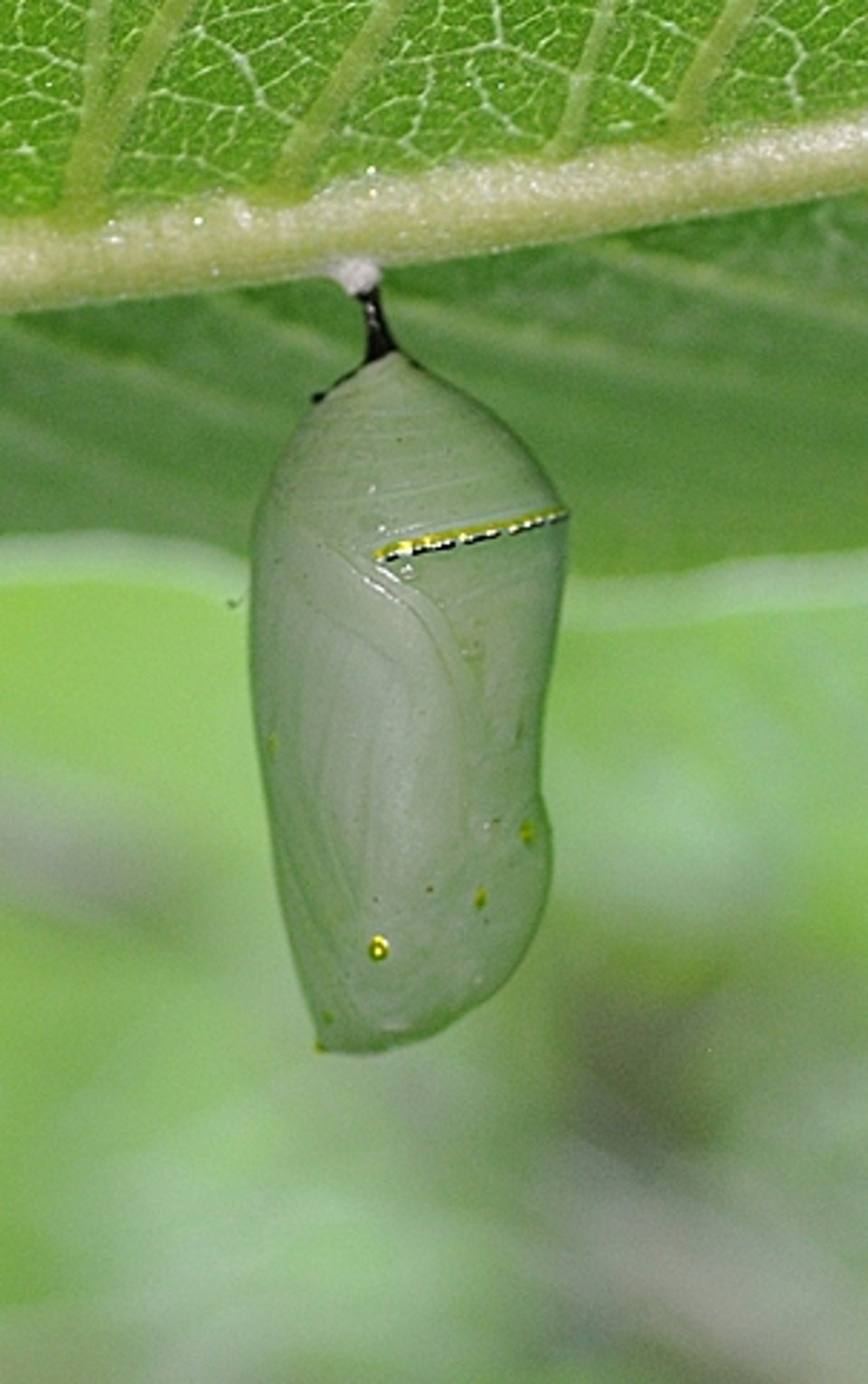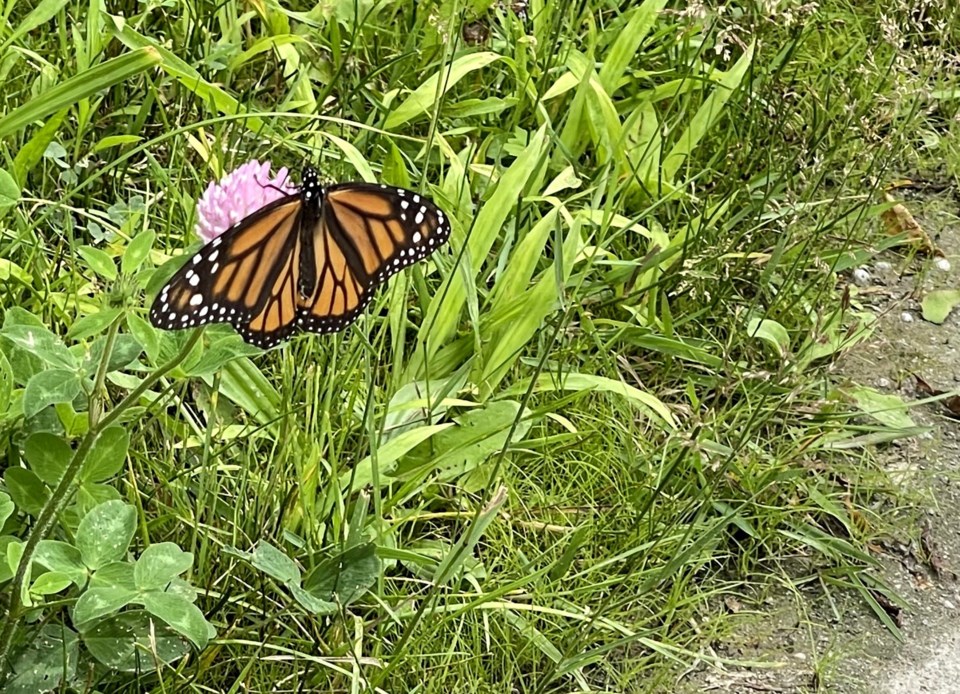Last week I covered the overall plight of monarch butterflies: their crashing populations, widespread habitat loss, and variable government protection plans.
Continuing with this species, there is quite a touchy controversy brewing about how best to assist these butterflies ... dive in and give them a direct hand, or back off and focus on the bigger threat of habitat loss?
No doubt most of you, like me, have found a monarch caterpillar, put it in a jar, fed it milkweed leaves and watched in awe as the caterpillar turned into a beautiful green chrysalis that, a few days later, emerged as a gorgeous orange-and-black adult butterfly.
Usually this adult was then released back to the wild (or, if this experiment was done in the 1960s ... said butterfly was destined for the killing jar and spreading board ... such were the activities of young naturalists in those days).
Nowadays the practice of collecting wild caterpillars and raising them to adulthood is a huge activity that has attracted hundreds, perhaps thousands, of people to become engaged in ‘saving the monarch butterfly’. This well-intentioned activity is to ensure that many adult butterflies can be added to the population and hopefully help the species retain its presence on the planet.

And sometimes ... we can love something to death. Unintentionally, for sure. But whenever people meddle with wildlife the ripple effects, the second steps, the hidden threats, the side effects, must be looked at and respected.
A plethora of articles are to be found on the internet, both supporting and condemning the raising and release of captive butterflies. So, before you go out and collect a jar full of ‘cats’ be aware of some of the challenges of creating butterflies.
There are several ‘things’ you need to be aware of, both biological and legal. In Ontario it is illegal to hold captive more than one individual of a native species without a permit (and then only until said individual can be released back to the wild). So, one caterpillar is OK, but two or more technically require you to be issued a permit from the Ontario Ministry of Natural Resources and Forestry.
However, word on the street is that the MNRF is not issuing permits to individuals. Which means to be a legal caretaker of wild caterpillars you need to be a member of an organization that has a ‘blanket’ permit to enlist ‘assistants’. In that case, you need to check out the website for the Toronto Entomologists’ Association (hint, hint). Enrolled and approved assistants can house up to 100 caterpillars.
In natural conditions, within the great outdoors, only 10 wild caterpillars out of every 100 make it to adulthood. In unnatural conditions, within the great indoors, about 99 out of 100 survive to be an adult. Based on that factoid, it seems to make sense this will increase the monarch butterfly population in leaps and bounds. Alas, this is not so.
Depending on where these 99 are released, there may not be enough milkweeds available for the next generation of eggs to be laid, or pollen rich flowers for the butterflies to gain energy. This seems kind of trivial, but urban raised butterflies have a real challenge finding matching habitat that includes all the food and shelter required to sustain both themselves and the next generation.
Another challenge with looking after a pen full of caterpillars is finding enough milkweed leaves to feed them all, everyday. A couple years ago a milkweed plant, growing outside the office I was stationed at, had eight caterpillars upon it. The leaves were quickly devoured and the half-grown caterpillars were obviously starving. This was nature’s way of staving off overpopulation; only one can survive.
If you collect handfuls of wild milkweed leaves every day to feed your captive ‘cats’, where will the wild monarchs find other milkweed plants upon which to lay their eggs?
Boy, this column is really becoming a ‘downer.’ But wait, there’s more.
Whenever a wild animal is held in close proximity to many others (overcrowding) the captive population tends to be weakened and therefore susceptible to bacteria, viruses and nasty little predatory insects.
There has been a surge in finding Ophyrocycstis elektroscirrha (much more easily referred to as OE) in monarchs. This is a protozoan parasite that invades the chrysalis and the emerging butterfly cannot open its wings.
So far we’ve covered captive rearing (short-term caretaking) now let’s look at captive breeding.
Some entrepreneurs have found a way to make money from your emotional response of “wanting to help”. These companies keep in captivity hundreds of adults for numerous generations, collect all the eggs, and sell the about to emerge chrysalis in large containers to weddings and funerals. At about $20 a critter, not too shabby a return.
It is within this industry that real negative impacts can be found. Research projects studying the health and survivability of these captive bred and reared butterflies have found that few of these captive bred butterflies know how or where to migrate, and that they lack ‘street smarts’ or genetic diversity.
Now the few wild butterflies that are flitting about find themselves surrounded by dozens of their kind, and well, let the mating begin! However, the competition is now intense for a wild female to find a wild male to procreate offspring with survival capabilities (and a mental flight plan to get to Mexico for the winter).
So how can you truly help the monarch butterfly?
Plant milkweed gardens where farm fields have been turned into housing developments. Plant pollinator gardens of native wildflowers to assist migrating adult monarchs with a much needed energy supply. Advocate for the protection of monarch habitat, including a ban on mowing milkweeds in the local parks and playgrounds.
Do not order captive bred butterflies of any kind.
But hey, nothing stopping you from kidnapping a single caterpillar and watching it do what nature does, perform magic by turning a crawling slug into a flying entity. Just make sure to skip the killing jar and spreading board, OK?
